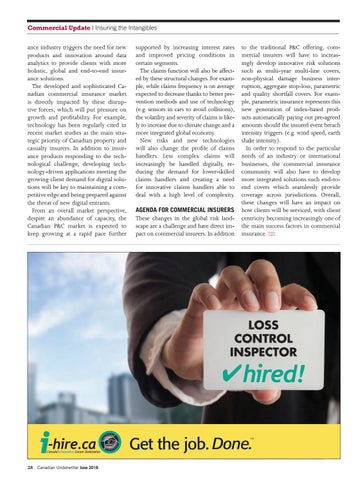Commercial Update l Insuring the Intangibles ance industry triggers the need for new products and innovation around data analytics to provide clients with more holistic, global and end-to-end insurance solutions. The developed and sophisticated Canadian commercial insurance market is directly impacted by these disruptive forces, which will put pressure on growth and profitability. For example, technology has been regularly cited in recent market studies as the main strategic priority of Canadian property and casualty insurers. In addition to insurance products responding to the technological challenge, developing technology-driven applications meeting the growing client demand for digital solutions will be key to maintaining a competitive edge and being prepared against the threat of new digital entrants. From an overall market perspective, despite an abundance of capacity, the Canadian P&C market is expected to keep growing at a rapid pace further
supported by increasing interest rates and improved pricing conditions in certain segments. The claims function will also be affected by these structural changes. For example, while claims frequency is on average expected to decrease thanks to better prevention methods and use of technology (e.g. sensors in cars to avoid collisions), the volatility and severity of claims is likely to increase due to climate change and a more integrated global economy. New risks and new technologies will also change the profile of claims handlers. Less complex claims will increasingly be handled digitally, reducing the demand for lower-skilled claims handlers and creating a need for innovative claims handlers able to deal with a high level of complexity. AGENDA FOR COMMERCIAL INSURERS These changes in the global risk landscape are a challenge and have direct impact on commercial insurers. In addition
to the traditional P&C offering, commercial insurers will have to increasingly develop innovative risk solutions such as multi-year multi-line covers, non-physical damage business interruption, aggregate stop-loss, parametric and quality shortfall covers. For example, parametric insurance represents this new generation of index-based products automatically paying out pre-agreed amounts should the insured event breach intensity triggers (e.g. wind speed, earth shake intensity). In order to respond to the particular needs of an industry or international businesses, the commercial insurance community will also have to develop more integrated solutions such end-toend covers which seamlessly provide coverage across jurisdictions. Overall, these changes will have an impact on how clients will be serviced, with client centricity becoming increasingly one of the main success factors in commercial insurance.
LOSS CONTROL INSPECTOR
28
Canadian Underwriter June 2018
